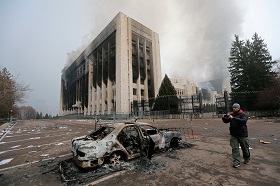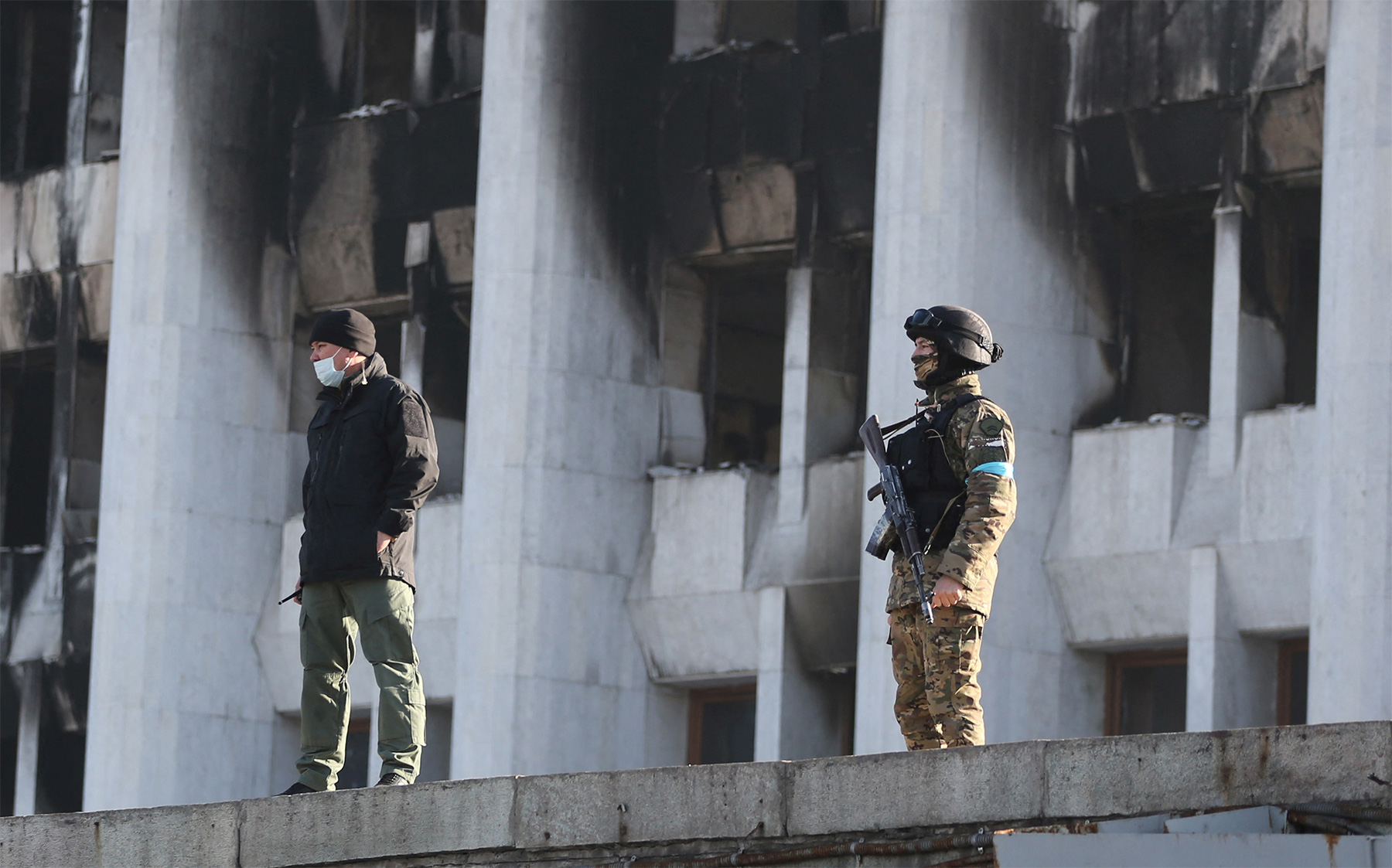For Kazakhstan, a transformation of its economic model should become the crucial consequence of the January rioting. Kazakhstan’s post-Soviet economic model rested on several principles. This includes a prioritized concentration on the extractive sector, primarily its oil- and gas-producing industry, where foreign companies play the leading role; a policy aimed at attracting more foreign investment, which used to be truly multi-vector as the U.S., some of the European nations, China, and Russia invested in Kazakhstan; and a large quasi-governmental sector with Nur-Sultan Nazarbayev’s family controlling most valuable of the assets, either directly or indirectly. Despite the declared adherence to a neoliberal course throughout the post-Soviet period, the state remained Kazakhstan’s largest employer.
The first signs of this model failing manifested themselves in the late 2000s. Over the last 15 years, Kazakhstan has passed through two economic crises (in 2007–2008 and in 2014–2015), which resulted in a threefold devaluation of the national currency. At the same time, Kazakhstan is facing price increases, reduced volumes of construction, industrial manufacturing and foreign trade, and a plethora of social issues. The pandemic has delivered another serious blow to the economy.
Today, Kazakhstan is going through an acute crisis of its economic model, whose foundations still include expanding mineral resource exports and developing the consumer sector domestically.
The main objective as of today is developing non-resource exports, privatizing state and quasi-state economic sectors, increasing population’s income, creating market niches at old markets and tapping new markets. During the transformation of the economic model, influence enjoyed by the family of Kazakhstan’s first president on the economy will gradually decrease, while large foreign companies (primarily, Western ones) will retain their standing, and Russian corporations will increase their influence in Kazakhstan.
Preconditions for protests
The deepening gap between what can be seen as economic successes and the low quality of life that a majority of the population has to endure, coupled with a super-concentration of national wealth in the hands of the elite and a resource-based economy that depends on large international companies and the situation on the world market, seem to have become the principal social and economic preconditions for the powerful protests that gripped Kazakhstan in January 2022.
Following a major transformative crisis after the collapse of the Soviet Union, Kazakhstan banked on developing production and exports of mineral resources, reviving its economy and achieving impressive successes—a trend assisted by a wealth of mineral resources, plenty of foreign investment, and a favorable situation on the global market. Still, average wages and income in Kazakhstan are significantly lagging behind countries of Eastern Europe or Russia, which follow a similar development trajectory. Apart from low wages and income, high unemployment (about 5%) and self-employment (in the 3rd quarter of 2021, Kazakhstan had 2.13 million self-employed persons) stand in the way of securing sustainable economic growth. The income of a large chunk of the population lasts them no more than from payday to payday, which means they are forced to take out loans, thus increasing the population’s debt burden.
Kazakhstan’s uneven socioeconomic development is particularly manifested if broken down by region. Unemployment remains highest in the south of Kazakhstan, in Almaty and Shymkent, as well as in the region of Turkistan. More than half of the self-employed are also concentrated in the south. Besides, Kazakhstan is faced with a rather urgent housing problem. Over 2.5 million people, or 14% of the entire population, need better housing—at year-end 2020, per capita housing was only 22.6 square meters. Again, broken down by region, the situation is the worst in the densely populated south. For instance, per capita housing is 17 square meters in the Jambyl Region, 18.7 square meters in the Turkistan Region, 20.2 square meters in the Amlaty Region, and 20 square meters in Almaty. Additionally, over 40% of those who dwell in Kazakhstan’s large cities are renters. The pandemic of COVID-19 has exacerbated the situation for many Kazakhstanis. Loss of employment, illness and death of their relatives, growing prices for goods and services have all served to aggravate the already difficult socioeconomic situation. For instance, rental prices in Almaty grew by 30% in 2020–2021.
Civil activity’s three factors: NGOs, blood ties, and extremists
The January protests in Kazakhstan manifested an extensive geographic reach while developing at a breakneck pace. During a couple of days—literally—rallies and riots spread over 10 regions, with some of the regional authorities losing control of the situation. The post-Soviet period in Kazakhstan saw a number of network structures emerge, ones that provided the basis for the population’s rapid self-organization during the riots, nationwide.
First, there is a network of non-governmental organizations, which have sprung up in every region over the last 30 years. The government’s data suggests that some 22,000 NGOs were registered in Kazakhstan as of 2020; of them, 16,000 were quite active, involving hundreds of thousands of people in their activities.
Second, blood ties remain truly strong in Kazakhstan, particularly in the south and in the west, which allows for a rapid rallying of friends and the entire extended family in case such a need arises.
Third, a network of underground Islamist groups has shaped up in Kazakhstan over the last 10–15 years. Some of them became actively involved in the attacks on law enforcement and authorities.
Besides, Kazakhstan has an extensive network of criminal and semi-criminal organized groups. Almaty and its Region are crime-ridden, with Kazakhstan’s every fourth crime committed there. In total, the south of Kazakhstan—where the heaviest rioting took place—accounts for some 43% of the crimes committed across the country. Almaty and Shymkent, the largest cities in the south, are mired with the highest per capita crime rates.
What is more, Kazakhstan’s south is an area of complicated inter-ethnic relations. Over the last ten years, it saw a few dozens of inter-ethnic conflicts, with some of them turning into major clashes and resulting in casualties. For instance, in 2015, Kazakhs had a conflict with Tajiks in the region of Turkistan; in 2016, a similar situation happened with Meskhetian Turks in the Jambyl Region, while another clash in the Jambyl region unfolded in 2020, this time with the Dungans.
Land reform rallies of April–May 2016 provided an example of a large nation-wide protest. Despite a prohibition from the authorities, about 20,000 people in a dozen Kazakhstani cities took part in the protests, while most of these cities came to be the centers of anti-governmental rallies in January, 2022. Another example can be provided by the rallies in Nur-Sultan and Almaty following the announcement of the 2019 presidential elections’ outcome.
In any case, January 2022 witnessed an attempt to ride the wave of a spontaneous popular protest and use it to achieve political objectives. A whimsical mixture of citizens driven to despair, political activists and radicals, Islamists, criminals, and fringe elements of all stripes provided the right mixture for the “Molotov cocktail” that blew up Almaty and a number of other regional centers in Kazakhstan.
Consequences of the January 2022 events
For Kazakhstan, a transformation of its economic model should become the crucial consequence of the January rioting. Kazakhstan’s post-Soviet economic model rested on several principles. This includes a prioritized concentration on the extractive sector, primarily its oil- and gas-producing industry, where foreign companies play the leading role; a policy aimed at attracting more foreign investment, which used to be truly multi-vector as the U.S., some of the European nations, China, and Russia invested in Kazakhstan; and a large quasi-governmental sector with Nur-Sultan Nazarbayev’s family controlling most valuable of the assets, either directly or indirectly. Despite the declared adherence to a neoliberal course throughout the post-Soviet period, the state remained Kazakhstan’s largest employer.
The first signs of this model failing manifested themselves in the late 2000s. By 2015, Kazakhstan achieved major successes, though: it was the second-largest economy in the post-Soviet space, catching up with Eastern European states in its economic development. The World Bank has it that the GDP by PPP in Kazakhstan (USD 25,877) in 2015 was comparable to the figures for Poland (USD 26,135), higher than in such EU states as Latvia (USD 24,286), Croatia (USD 21,880), Romania (USD 21,403), and Bulgaria (USD 17,512). By the late 2010s, the situation had changed, and Kazakhstan’s pace of development significantly slowed down. According to the World Bank, Kazakhstan’s GDP by PPP in 2020 was USD 26,729, significantly below the figures for Latvia (USD 32,019), Croatia (USD 28,504), and Romania (USD 31,946), and only somewhat higher than those of Bulgaria (USD 24,367). Over the last 15 years, Kazakhstan has passed through two economic crises (in 2007–2008 and in 2014–2015), which resulted in a threefold devaluation of the national currency. At the same time, Kazakhstan is facing price increases, reduced volumes of construction, industrial manufacturing and foreign trade, and a plethora of social issues. The pandemic has delivered another serious blow to the economy.
Today, Kazakhstan is going through an acute crisis of its economic model, whose foundations still include expanding mineral resource exports and developing the consumer sector domestically. Along with many post-Soviet states (Russia, Azerbaijan, and Turkmenistan) that have large mineral deposits, Kazakhstan in the 2000s, amid explosively growing hydrocarbon prices, built a resource-based economic model that allowed it to achieve impressive success.
However, the resource super-cycle concluding at the global markets, economic crisis in Russia, and China and EU economies slowing down closed the chapter on developing this model. The main objective as of today is developing non-resource exports, privatizing state and quasi-state economic sectors, increasing population’s income, creating market niches at old markets and tapping new markets. During the transformation of the economic model, influence enjoyed by the family of Kazakhstan’s first president on the economy will gradually decrease, while large foreign companies (primarily, Western ones) will retain their standing, and Russian corporations will increase their influence in Kazakhstan.






